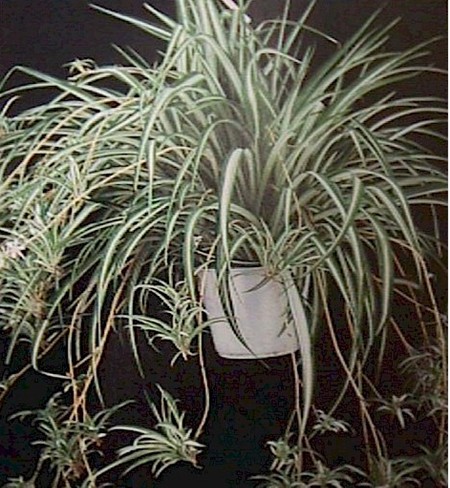Spider Plants
By Jos Van Hage
 The Spider Plant (Chlorophytum comosum) is one of the most popular, and familiar houseplants. Native to Africa it is a member of the lily family. The long, grass like foliage stems from a clump and what makes the plant a fascination for many people are the long, cascading wiry stems that produce small white flowers that are later followed by miniature plants. Another reason for the plants popularity is that it is very adaptable to many different conditions.
The Spider Plant (Chlorophytum comosum) is one of the most popular, and familiar houseplants. Native to Africa it is a member of the lily family. The long, grass like foliage stems from a clump and what makes the plant a fascination for many people are the long, cascading wiry stems that produce small white flowers that are later followed by miniature plants. Another reason for the plants popularity is that it is very adaptable to many different conditions.
The spider plant will tolerate bright light to partial shade however; it does best in bright light. It does not like full hot sun as this causes the plant to burn so stay away from a south facing summer window. It is also not fussy about the room temperature but it can not take a frost. Another nice feature is that it will tolerate dry or humid air and will not die if it is left too dry every once in a while. Ideally the plants soil should be allowed to go slightly dry between waterings during the winter months when the plant is dormant and in the spring/summer when the plant is growing increase on the water so that the soil is kept slightly moist. Fertilize the plant with 20-20-20 every month during the growing period and every 2 months in the winter months.
The spider plant makes a beautiful hanging plant and can grow 0.9 m tall with the stems reaching up to 1.5 m long. The foliage is long (20-30 cm) and narrow (2.0-2.5 cm) and is variegated with green and white or yellow. The plant is easily propagated as the little plantlets (baby plants formed on the stems) root very easily. They can either be left on the plant and placed on top of the soil or they can be removed from the plant and placed on top of the soil so that they can form roots. If you do not want to propagate new plants then leave the plantlets on the plant as this adds to the appearance of the plant. For the plant to make plantlets it must be healthy and slightly root bound.
A problem that the spider plant can have sometimes is that the leaves can have brown tips. These are caused by letting the plant to go too dry or by high soluble salts that collect in the soil. The brown tips can be cut off with a good pair of scissors. To help prevent the problem use rain water to water the plant and if the problem continues leach the soil out with fresh water.
- Jos
Jos Van Hage owns two Art Knapp Garden Centres in Prince George:
- Highway 97 North at Northwood Pulpmill Road
- Highway 16 West at Kimball Road
Previous Story - Next Story
Return to Home









